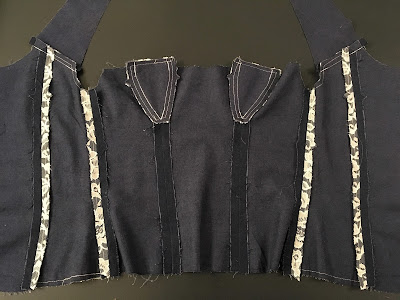This semester, I decided to try something new and enrolled in a studio art class that explores the traditional and contemporary uses of the sketchbook. The class emphasizes both the keeping of a sketchbook itself, as an essential tool in the development, practice and documentation of the creative process, and the exploration of a variety of materials and techniques. Through a weekly series of 5-6 completed pieces of self-directed work and assigned projects, the demands are both challenging and rewarding from ideation to creation and critique.
 |
| (Photograph via: Pinterest) |
The last challenge presented to the class was transforming trash and recyclable materials into art. We were given two weeks, and few restrictions beyond using re-purposed materials and that nothing new could be purchased. That same class, we were instructed to brainstorm usable materials and project ideas.
Immediately, I knew that I wanted to create a piece of wearable art. And not just any garment, but one that made a statement. Combining both water pollution concerns and early 19th century undergarments, the "strange waters stays" project was born!
 |
| The initial brainstorming. |
For my nontraditional, recycled corset materials, I chose to re-purpose denim from a donated skirt and lace from donated curtains for the outer layer. I also chose to use bright green bias tape, an accidental purchase wasting away in the stash, for binding.
 |
| Front view. Notice that the seams and boning channels are marked. |
For the inside, I selected an ocean blue cotton from the stash for the interlining, and my previous shower curtain liner, which needed to be replaced anyways, for the lining. The "pollution" included tin foil and coffee filters, and the "lily pads" were leaves left over from a plastic flower bunch.
More views of the stays. Each sketch was worked in pencil, ink and watercolor. I intended to use metal grommets and shoe strings for lacing, plastic zip ties for boning, and either a paint stick or cardboard to serve as the front busk.
I thought that the lace overlays would add some visual interest to the outside, but also would serve as a metaphor for our lakes and waterways - scenic beauty at first glace with the sinister truth of death and decay lurking beneath the water's surface.
 |
| Side view showing lace overlays, boning placement and stitching lines. |
 |
| Back view, also showing seam and boning placement. |
After our designs were presented and approved in the following class, we were given one week to assemble our projects. Enter phase three: the construction process! Because this was such a new experience, I did my best to document each step.
First, I cut out each layer - lace overlays, denim outer, cotton interlining and shower curtain lining. (Yes, I wiped down the shower curtain liner before use...)
 |
| Lots of layers! |
Then, I assembled the outer denim shell, flat-lining the lace overlays to the bust gussets and side back pieces. This was a new technique for me.
Constructing the inter lining was next. This is where I had to get creative and adjust to the challenges of working with the non-traditional materials as they arose.
I played around with the placement of the "pollution" until satisfied. The coffee filters were crumpled and pleated to resemble lily pads, while wadded pieces of aluminum foil were interspersed among the "lily pads" or plastic leaves. This represents how human litter, intentional or unintentional, silently chokes plant and marine life, forever altering those ecosystems. Once everything is dead, such strange waters are the only thing left.
 |
| Artistically arranging the polluted waters with paper coffee filters, pleated to resemble lily pads, plastic leaves and shiny foil, three types of litter that end up in our waters. |
Originally, I planned on hand tacking everything, but decided to save time and zig-zag all of the edges. Or so I thought...this process seemed to take the longest of the steps as neither machine, nor I was used to sewing with the non-traditional materials. Only one broken needle!
 |
| Zig-zagged in place. |
Assembling the lining was tricky because of the bulk in each seam. I did my best to press the seams flat using the lowest setting on the iron and a cotton cloth to prevent any melting...
Aligning the outer and lining layers, wrong sides to the inside, I stitched along the upper edges and stitched-in-the-ditch to join several seams. I found it very difficult to stitch through all of the rather stiff layers, so decided to skip the boning except at the back edges. Now at the 16 hour mark, with the binding just pinned, I had completed all that I could before class...Stay tuned for the final results in part II!












Oh...my...gosh! These are going to be so epic! I am loving all the plant detail!! Please hurry and share more!!!
ReplyDeleteBlessings!
g
Thanks for brightening my day with your lovely comment! Just posted part two :)
Delete